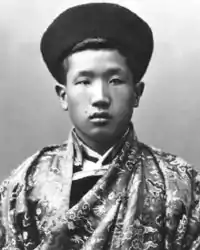Kingdom of Sikkim
The Kingdom of Sikkim (Classical Tibetan and Sikkimese: འབྲས་ལྗོངས། Drenjong), earlier known as Dremoshong (Classical Tibetan and Sikkimese: འབྲས་མོ་གཤོངས།, official name until 1800s), was a hereditary monarchy from 1642 to 16 May 1975 in the Eastern Himalayas. It was ruled by Chogyals of the Namgyal dynasty.
Kingdom of Sikkim འབྲས་ལྗོངས། (Sikkimese) Drenjong འབྲས་མོ་གཤོངས། (Classical Tibetan) Dremoshong ᰕᰚᰬᰯ ᰜᰤᰴ (Lepcha) Mayel Lyang | |||||||
|---|---|---|---|---|---|---|---|
| 1642–1975 | |||||||
 Coat of arms
| |||||||
 Historical map of Sikkim in northeastern India | |||||||
| Status |
| ||||||
| Capital | |||||||
| Common languages | |||||||
| Religion | Tibetan Buddhism | ||||||
| Demonym(s) | Drenjop, Sikkimese | ||||||
| Government | Monarchy | ||||||
| Chogyal | |||||||
• 1642–1670 (first) | Phuntsog Namgyal | ||||||
• 1963–1975 (last) | Palden Thondup Namgyal | ||||||
| Legislature | State Council of Sikkim | ||||||
| History | |||||||
• Established | 1642 | ||||||
• Treaty of Titalia signed | 1817 | ||||||
| 1835 | |||||||
• Palden Thondup Namgyal forced to abdicate | 1975 | ||||||
• Merger with India | 16 May 1975 | ||||||
| Currency | Paisa Rupee | ||||||
| |||||||
| Today part of | |||||||
| Princely state |
|---|
| Individual residencies |
|
| Agencies |
|
| Lists |
| Outline of South Asian history |
|---|
_without_national_boundaries.svg.png.webp) |
History
Nepalese domination
In the mid-18th century, Sikkim was invaded by Nepal (then the Gorkha Kingdom) and was under the Gorkha rule for more than 40 years. Between 1775 and 1815, almost 180,000 ethnic Nepalis from Eastern and Central Nepal migrated to Sikkim. After the British colonisation of India, however, Sikkim allied itself with British India as they had a common enemy – Nepal. The infuriated Nepalese attacked Sikkim with vengeance, overrunning most of the region including the Terai. This prompted the British East India Company to attack Nepal in 1814, resulting in the Anglo-Nepalese War. The Sugauli Treaty between Britain and Nepal and the Treaty of Titalia between Sikkim and British India resulted in territorial concessions by Nepal, which ceded Sikkim to British India.[3]
British and Indian protectorate
Under the 1861 Treaty of Tumlong Sikkim became a British protectorate, then an Indian protectorate in 1950.[4]
Accession to India
In 1975, allegations of discrimination against Nepali Hindus in Sikkim led to resentment against the Chogyal.[5][6] Their instigation led to Indian Army personnel moving into Gangtok. According to Sunanda K. Datta-Ray of The Statesman, the army killed the palace guards and surrounded the palace in April 1975.[4]
After disarming the palace, a referendum on the monarchy was held, in which the Sikkimese people overwhelmingly voted to abolish the monarchy, and the new parliament of Sikkim, led by Kazi Lhendup Dorjee, proposed a bill for Sikkim to become an Indian state, which was promptly accepted by the Government of India.[4][7]
Culture and religion
In culture and religion, Sikkim was linked closely with Tibet, from which its first king migrated, and Bhutan, with which it shares borders. The presence of a large ethnic Nepali population, mainly from eastern and central Nepal, also leads to cultural linkages with Nepal.
List of Chogyals of Sikkim (1642–1975)
| No. | Reign | Portrait | Chogyal (Lifespan) |
Events |
|---|---|---|---|---|
| 1 | 1642–1670 |  |
Phuntsog Namgyal (1604–1670) |
Ascended the throne and was consecrated as the first Chogyal of Sikkim. Made the capital in Yuksom. |
| 2 | 1670–1700 |  |
Tensung Namgyal (1644–1700) |
Shifted capital to Rabdentse from Yuksom. |
| 3 | 1700–1717 |  |
Chakdor Namgyal (1686–1717) |
His half-sister Pendiongmu tried to dethrone Chakdor, who fled to Lhasa, but was reinstated as king with the help of Tibetans. |
| 4 | 1717–1733 |  |
Gyurmed Namgyal (1707–1733) |
Sikkim was attacked by Nepalis. |
| 5 | 1733–1780 |  |
Phuntsog Namgyal II (1733–1780) |
Nepalis raided Rabdentse, the then capital of Sikkim. |
| 6 | 1780–1793 |  |
Tenzing Namgyal (1769–1793) |
Chogyal fled to Tibet, and later died there in exile. |
| 7 | 1793–1863 |  |
Tsugphud Namgyal (1785–1863) |
The longest-reigning Chogyal of Sikkim. Shifted the capital from Rabdentse to Tumlong. Treaty of Titalia in 1817 between Sikkim and British India was signed in which territories lost to Nepal were appropriated to Sikkim. Darjeeling was gifted to British India in 1835. Two Britons, Dr. Archibald Campbell and Dr. Joseph Dalton Hooker were captured by the Sikkimese in 1849. Hostilities between British India and Sikkim continued and led to a treaty signed, in which Darjeeling was ceded to the British Raj. |
| 8 | 1863–1874 |  |
Sidkeong Namgyal (1819–1874) |
|
| 9 | 1874–1914 |  |
Thutob Namgyal (1860–1914) |
John Claude White appointed as the first political officer in Sikkim in 1889. Capital shifted from Tumlong to Gangtok in 1894. |
| 10 | 1914 |  |
Sidkeong Tulku Namgyal (1879–1914) |
The shortest-reigning Chogyal of Sikkim, ruled from 10 February to 5 December 1914. Died of heart failure, aged 35, in most suspicious circumstances. |
| 11 | 1914–1963 |  |
Tashi Namgyal (1893–1963) |
Treaty between India and Sikkim was signed in 1950, giving India suzerainty over Sikkim. |
| 12 | 1963–1975 |  |
Palden Thondup Namgyal (1923–1982) |
The last Chogyal of Sikkim. The country became a state of India, following the 1975 referendum. |
The son from the first marriage of Palden Thondup Namgyal, Wangchuk Namgyal (born 1 April 1953), was named the 13th Chogyal after his father's death on 29 January 1982, but the position no longer confers any official authority since 2003.[8]
See also
References
- Hiltz, Constructing Sikkimese National Identity 2003, p. 80–81.
- According to Article II of Convention of Calcutta, Sikkim was a direct protectorate of the British Government, not the British Indian government.
- "History of Nepal: A Sovereign Kingdom". Official website of Nepal Army. Archived from the original on 7 June 2011.
- "Indian hegemonism drags Himalayan kingdom into oblivion". Nikkei Asian Review. Nikkei. 21 February 2016. Archived from the original on 3 April 2017. Retrieved 24 July 2018.
- Larmer, Brook (March 2008). "Bhutan's Enlightened Experiment". National Geographic. Bhutan. (print version).
- "25 years after Sikkim". Nepali Times (#35). 23–29 March 2001.
- Sethi, Sunil (18 February 2015). "Treaties: Annexation of Sikkim" (2). India Today. India Today. Retrieved 4 December 2016.
- "2003年6月24日外交部发言人在记者招待会上答记者问" (in Chinese). Ministry of Foreign Affairs (China). 25 June 2003. Retrieved 12 February 2008.
Works cited
- Hiltz, Jackie (2003), "Constructing Sikkimese National Identity in the 1960s and 1970s" (PDF), Bulletin of Tibetology
Further reading
- Duff, Andrew (2015). Sikkim: Requiem for a Himalayan Kingdom. Edinburgh: Birlinn. ISBN 978-0-85790-245-0.
- Rai, Rajiv (2015), The State in the Colonial Periphery: A Study on Sikkims Relation with Great Britain, Partridge Publishing India, ISBN 978-1-4828-4871-7
- Rose, Leo E. (Spring 1969), "India and Sikkim: Redefining the Relationship", Pacific Affairs, 42 (1): 32–46, JSTOR 2754861
- Rose, Leo E. (1971), Nepal – Strategy for Survival, University of California Press, ISBN 978-0-520-01643-9
- Singh, Amar Kaur Jasbir (1988), Himalayan triangle: a historical survey of British India's relations with Tibet, Sikkim, and Bhutan, 1765-1950, British Library
- Sharma, Suresh Kant; Sharma, Usha (2005), Discovery of North-East India: Geography, History, Culture, Religion, Politics, Sociology, Science, Education and Economy. Sikkim. Volume ten, Mittal Publications, pp. 117–, ISBN 978-81-8324-044-4
.svg.png.webp)